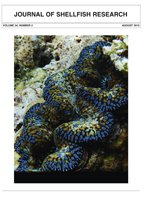The northern hard clam Mercenaria mercenaria is one of the most commercially important bivalve species produced via aquaculture in the eastern United States. Breeding practices associated with large-scale hatchery production of hard clam seed may result in unintended, potentially negative consequences including inbreeding and reduced levels of genetic diversity. Seven microsatellite markers were used to compare levels of genetic diversity in six hatchery stocks and four wild stocks from the state of Florida. Wild stocks of M. mercenaria had slightly higher levels of allelic richness and similar observed heterozygosity (wild = Ar = 3.61,Ho = 0.448; hatchery = Ar = 3.46,Ho = 0.452); however, these differenceswere not statistically significant (Ar: P = 0.145; Ho: P = 0.931). Differentiation was highest between hatchery stocks (GST = 0.03, SD = 0.007; P < 0.001) but minimal among hatchery-by-wild comparisons. In contrast, wild stocks were not differentiated (GST = -0.002, SD = 0.004; P ≈ 0.58) and Bayesian comparisons of competing gene flow models (panmixia, stepping stone, and full-migration) suggested that wild stocks were effectively panmictic at this scale. Together, these results indicate that some genetic drift has occurred within hatchery populations, possibly as a result of broodstock selection and spawning practices. The genetic divergence between wild and hatchery stocks observed in this study are not as pronounced as seen in other aquaculture bivalve species. Given the large scale of hard clam production in Florida we argue that hatchery practices should incorporate long-term genetic goals (i.e., avoidance of inbreeding) to maintain the integrity of hatchery stocks. A secondary objective of this study was to amplify a congeneric species, Mercenaria campechiensis, using the same suite of microsatellite markers to assess their utility for detecting interspecific hybridization. Amplification success was poor and failed for four of the seven loci. The identification of microsatellite loci for different species of Mercenaria should be identified de novo in the future.
How to translate text using browser tools
1 August 2015
Assessment of Genetic Diversity in Wild and Aquaculture Stocks of Mercenaria mercenaria in Florida
John S. Hargrove,
Leslie Sturmer,
John Scarpa,
James D. Austin
ACCESS THE FULL ARTICLE

Journal of Shellfish Research
Vol. 34 • No. 2
August 2015
Vol. 34 • No. 2
August 2015
aquaculture
clam
Mercenaria mercenaria
microsatellites
Northern quahog
panmixia
population genetics




